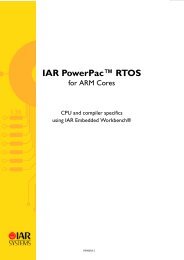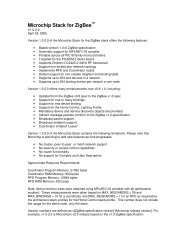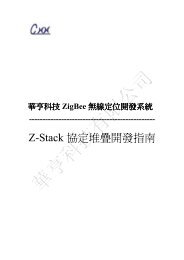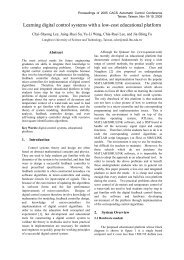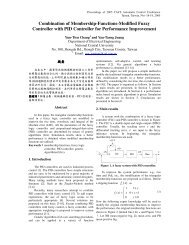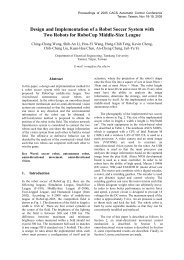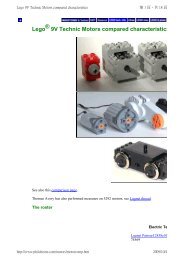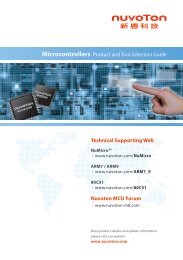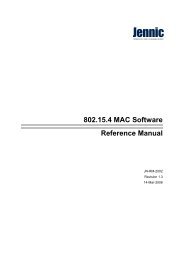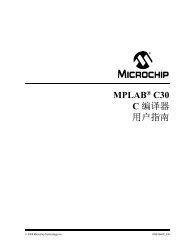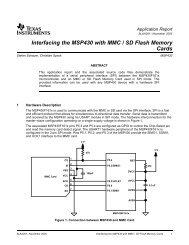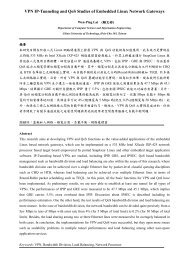- Page 1 and 2: IAR PowerPac RTOSUser GuidePPRTOS-2
- Page 3 and 4: PrefaceWelcome to the IAR PowerPac
- Page 5 and 6: ContentsPreface ...................
- Page 7 and 8: ContentsOS_WaitCSema() ............
- Page 9 and 10: ContentsOS_LeaveInterrupt() .......
- Page 11 and 12: Introduction to IAR PowerPacRTOSWha
- Page 13 and 14: Basic conceptsTasksIn this context,
- Page 15 and 16: Basic conceptsPREEMPTIVES MULTITASK
- Page 17 and 18: Basic conceptsMAILBOXES AND QUEUESA
- Page 19 and 20: Basic conceptsThe active task may b
- Page 21 and 22: Basic conceptsThe flowchart below i
- Page 23: Basic conceptsLIST OF LIBRARIESIn y
- Page 27 and 28: Task routinesOS_CREATETASK() can be
- Page 29 and 30: Task routinesExampleThe following e
- Page 31 and 32: Task routinesExampleint sec,min;voi
- Page 33 and 34: Task routinesAdditional Information
- Page 35 and 36: Task routinesReturn valueOS_TASKID:
- Page 37 and 38: Software timersSoftware timerA soft
- Page 39 and 40: Software timers#define OS_CREATETIM
- Page 41 and 42: Software timersOS_SetTimerPeriod()D
- Page 43 and 44: Software timersAdditional Informati
- Page 45 and 46: Software timersAdditional Informati
- Page 47 and 48: Software timersExampleOS_TIMER TIME
- Page 49 and 50: Resource semaphoresIntroductionReso
- Page 51 and 52: Resource semaphoresResource semapho
- Page 53 and 54: Resource semaphoresOS_Request()Desc
- Page 55 and 56: Counting SemaphoresIntroductionCoun
- Page 57 and 58: Counting SemaphoresPrototypevoid OS
- Page 59 and 60: Counting SemaphoresReturn value0: I
- Page 61 and 62: MailboxesWhy mailboxes?In the prece
- Page 63 and 64: MailboxesMailboxes API function ove
- Page 65 and 66: MailboxesExampleSingle-byte mailbox
- Page 67 and 68: MailboxesPrototypevoid OS_GetMail (
- Page 69 and 70: MailboxesOS_WaitMail()DescriptionWa
- Page 71 and 72: QueuesWhy queues?In the preceding c
- Page 73 and 74: QueuesReturn valueThe size of the r
- Page 75 and 76:
QueuesExamplestatic void MemoryTask
- Page 77 and 78:
Task eventsIntroductionTask events
- Page 79 and 80:
Task eventsExampleOS_WaitEventTimed
- Page 81 and 82:
Task eventsPrototypechar OS_ClearEv
- Page 83 and 84:
Event objectsIntroductionEvent obje
- Page 85 and 86:
Event objectsExampleif (OS_EVENT_Wa
- Page 87 and 88:
Event objectsExampleOS_EVENT_Reset(
- Page 89 and 90:
Heap type memory managementANSI C o
- Page 91 and 92:
Fixed block size memory poolsIntrod
- Page 93 and 94:
Fixed block size memory poolsProtot
- Page 95 and 96:
Fixed block size memory poolsProtot
- Page 97 and 98:
StacksIntroductionThe stack is the
- Page 99 and 100:
InterruptsIntroductionIn this chapt
- Page 101 and 102:
InterruptsRules for interrupt handl
- Page 103 and 104:
InterruptsOS_LeaveInterruptNoSwitch
- Page 105 and 106:
InterruptsNesting interrupt routine
- Page 107 and 108:
Critical RegionsIntroductionCritica
- Page 109 and 110:
System variablesIntroductionThe sys
- Page 111 and 112:
Configuration for your targetsystem
- Page 113 and 114:
Time measurementIntroductionIAR Pow
- Page 115 and 116:
Time measurementPrototypeU32 OS_Get
- Page 117 and 118:
Time measurementPrototypeOS_U32 OS_
- Page 119 and 120:
RTOS-aware debuggingThis chapter de
- Page 121 and 122:
RTOS-aware debuggingTimersA softwar
- Page 123 and 124:
DebuggingRuntime errorsSome error c
- Page 125 and 126:
DebuggingValue Define Description17
- Page 127 and 128:
Performance and resource usageThis
- Page 129 and 130:
Performance and resource usageThe c
- Page 131 and 132:
Performance and resource usage*/sta
- Page 133 and 134:
ReentranceAll routines that can be
- Page 135 and 136:
LimitationsThe following limitation
- Page 137 and 138:
Source code of kernel and libraryIn
- Page 139 and 140:
Additional modulesKeyboard manager:
- Page 141 and 142:
FAQ (frequently asked questions)Q:
- Page 143 and 144:
GlossaryActive TaskCooperativemulti
- Page 145 and 146:
IndexIndexAAdditional modules . . .
- Page 147:
IndexOS_WaitSingleEventTimed(). . .




